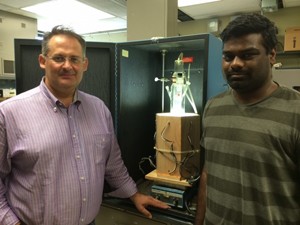
UC Engineering Professor Receives Recognition for Green Efforts
For 20 years, University of Cincinnati Chemical Engineering Professor Panagiotis (Peter) Smirniotis has pursued his passion for protecting the environment from both man-made and natural pollutants. His work has brought him many awards and recognitions from the United States government and various technical societies.
Most recently, Professor Smirniotis has been awarded the 2014 Lawrence K. Cecil Award of AIChE for his work, Protecting our Environment with Catalysis and Reaction Engineering.
The UC professor will present a plenary talk for his research in this area at the American Institute of Chemical Engineers (AIChE) Annual Meeting this November. This high honor comes with great excitement for the chemical engineering professor who says, This is a great reward from our society, of course, I am very happy that our work was recognized.
Environmental protection has been a hot topic for several decades. Its an effort many care about but only few individuals work hard to improve within their careers. Life gets busy, resources are demanded, and recycling gets forgotten. Professor Smirniotis has dedicated his work to bettering the environment both in preventative and corrective ways.
As he explains, there are two approaches to curing the environments pollution problem. The pro-active preventative measure aims to minimize future harm by eliminating potential hazards.
The other way in which environmental engineers seek to improve the environment is to correct the pollutants that already exist. Lakes, streams, ground have collected pollutants over decades, leaving extensive work behind for engineers to clean up. The UC professor and his students approach environmental issues from both directions for an all-around solution for protection.
As an environmental spokesperson, Professor Smirniotis projects span several different areas of great interest for the future. Changing refining and several chemical reactions to prevent pollution, producing hydrogen with cost effective processes, removing toxic gases from mobile and stationary sources, capturing carbon dioxide to reduce the Green-House effect leading to global warming, are some of the main areas he researched in his academic career at UC. Smirniotis work on photocatalysis focuses mainly on liquid and gaseous pollutants including his latest work which has received wide publicity.

One of the photocatalytic reactors Smirniotis and coworkers use
Broken down, photocatalytics is quite self-explanatory. Photo, meaning light, and catalytic, or catalysis, put together is simply the use of light coupled with catalysis (something that increases the rate of a chemical reaction), to destroy harmful pollutants.
The professor explains that while light is effective in killing harmful solvents, it is slow. Only about 5% of sunlight includes UV rays, which are needed for the destruction of pollutants with the conventional and widely used titania based photocatalysts.
Through his developments, Smirniotis is able to utilize the other 95% of visible light from the sun along with catalysis to clean water and gases for safer surroundings. This was achieved by developing inexpensive photocatalysts that will be able to work with visible light and thus utilize the visible part of the solar light.
The practical implication of this family of photocatalysts is the development of effective and high through-put engineering processes that could clean gaseous and aqueous streams of organic contaminants.
Smirniotis has dedicated his career to protecting the precious earth we take in every day. He wears his passion boldly, holding nothing back in his efforts in making a difference in our world.
When asked why he decided to study environmental problems, the professor explained that as an educator and researcher, it is important to find a meaningful field, You try to find areas that will make an impact; that are very resourceful. Peter Smirniotis recognizes the huge potential for impact in environmental science and strives to create change every day of his career.
Related Stories
UC’s Ground Floor Makerspace births combat robots
April 17, 2024
In the heart of UC's 1819 Innovation Hub lies the Ground Floor Makerspace, an advanced and active hub of ingenuity where students, faculty and the community converge to bring their ideas to life. This includes being the birthplace of robots much like miniature race cars, combating fender to fender in an enclosed boxing ring. Combat robots like UC's Maximizer will again be fighting for first place in the National Havoc Robot League (NHRL) competition, slated for April 20.
UC researchers develop new CPAP device
April 17, 2024
Researchers at the University of Cincinnati are developing a VortexPAP machine that takes advantage of vortex airflow technology. A preliminary clinical study with current CPAP users demonstrated that the VortexPAP can deliver the pressure levels that are used in the subjects’ CPAP therapy, but the mask is more comfortable to wear. It has a minimalistic design that is less intrusive and barely touches the patient’s face.
UC architectural engineering alumna inspires high school students
April 16, 2024
University of Cincinnati alumna Emma Wilhelmus fell in love with engineering when she was in ninth grade. After taking drafting, architecture and engineering courses in high school, she set out to major in architectural engineering in college. Now, she is an engineering teacher at a local high school and hopes to inspire students.
